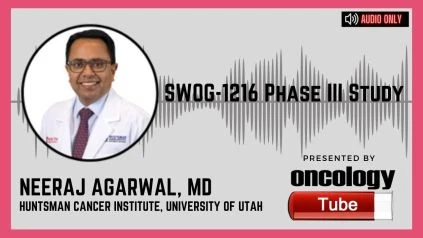Neeraj Agarwal, MD, Professor of Medicine, and a Presidential Endowed Chair of Cancer Research at the Huntsman Cancer Institute (HCI), University of Utah. He also directs the Genitourinary Oncology (GU) Program and the Center of Investigational Therapeutics (CIT) at the HCI. In this video, he speaks about Prostate Cancer OS Is Up Significantly.
Â
Observation –
Â
Intention:
Â
Orteronel (TAK-700) is a nonsteroidal androgen-suppressing 17,20-lyase inhibitor. We looked at how orteronel performed when combined with androgen deprivation therapy (ADT) in individuals with newly diagnosed metastatic hormone-sensitive prostate cancer.
Â
Methodology:
Â
Patients with metastatic hormone-sensitive prostate cancer were randomly assigned 1:1 to ADT with orteronel (300 mg oral twice daily; experimental arm) or ADT with bicalutamide in this open-label randomized phase III research (50 mg oral once daily; control arm). The major goal was to compare overall survival (OS), with the goal of improving median survival by 33%. A one-sided P.022 for a stratified log-rank test would suggest statistical significance. Secondary endpoints included progression-free survival (PFS), PSA level at 7 months (0.2 v 0.2 to 4 v > 4 ng/mL), and adverse event profile.
Â
Outcomes:
Â
The study included 1,279 patients, 638 of whom were randomly assigned to the ADT plus orteronel arm and 641 to the control arm. The median age was 68 years, and 49 percent of the patients had significant illness. There was a significant improvement in PFS (median 47.6 v 23.0 months, hazard ratio 0.58; 95 percent CI, 0.51 to 0.67; P.0001) and PSA response at 7 months (P.0001) after a median follow-up of 4.9 years, but not in OS (median 81.1 v 70.2 months, hazard ratio 0.86; 95 percent CI, 0.72 to 1.02; P =.040, one-sided). The experimental arms had more grade 3/4 adverse events than the control arms (43 percent v 14 percent ). Patients in the control arm received postprotocol life-prolonging therapy at a rate of 77.4 percent, while patients in the orteronel arm received it at a rate of 61.3 percent.
Â
Summary of findings:
Â
The primary end aim of better OS with orteronel was not met in the trial. The absence of connection between PFS and PSA response and OS raises issues about assuming that they are a reliable surrogate for OS in the context of substantial postprotocol therapy in this circumstance.

